Ichneumonidae
The Ichneumonidae, also known as the ichneumon wasps or ichneumonids, is a parasitoid wasp family within the insect order Hymenoptera. This insect family is among the most species-rich branches of the tree of life. At the same time, it is one of the groups for which our knowledge most severely lags behind their actual diversity. The roughly 25,000 species described today[1] probably represent less than a quarter of their true richness, but reliable estimates are lacking, as is much of the most basic knowledge about their ecology, distribution and evolution.[2] Ichneumonid wasps, with very few exceptions, attack the immature stages of holometabolous insects and spiders, eventually killing their hosts.[3] They thus fulfill an important role as regulators of insect populations, both in natural and semi-natural systems, making them promising agents for biological control.[4]
| Ichneumon wasps | |
|---|---|
| Diphyus sp., Rhône (France) | |
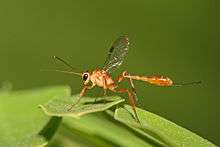 | |
| Anomaloninae, (Tanzania) | |
| Scientific classification | |
| Kingdom: | Animalia |
| Phylum: | Arthropoda |
| Class: | Insecta |
| Order: | Hymenoptera |
| Suborder: | Apocrita |
| Superfamily: | Ichneumonoidea |
| Family: | Ichneumonidae Latreille, 1802 |
| Subfamilies | |
|
See below | |
The most commonly recognized wasps are boldly colored social wasps whose females have venomous stings. They are in a separate clade: Aculeata. In contrast, ichneumonids have ovipositors instead of stingers, and they are all solitary. They use their ovipositors to lay eggs on or in the body of their prey, and the eggs hatch into carnivorous larvae that eat and kill the host.
The distribution of the ichneumonids was traditionally considered an exception to the common latitudinal gradient in species diversity, since the family was thought to be at its most species-rich in the temperate zone instead of the tropics, but numerous new tropical species have now been discovered.
Etymology and history
Insects in the family Ichneumonidae are commonly called ichneumon wasps, or ichneumonids. However, the term ichneumon wasps can refer specifically to the genus Ichneumon within the Ichneumonidae and thus cause confusion. A group of ichneumonid specialists have proposed Darwin wasps as a better vernacular name for the family.[4] Less exact terms are ichneumon flies (they are not closely related to true flies) and scorpion wasps due to the extreme lengthening and curving of the abdomen (scorpions are arachnids, not insects).
The name is derived from Latin 'ichneumon', from Ancient Greek ἰχνεύμων (ikhneúmōn, "tracker"), from ἴχνος (íkhnos, "track, footstep"). The name first appeared in Aristotle's "History of Animals", c. 343 BC. Aristotle noted that the ichneumon preys upon spiders, is a wasp smaller than ordinary wasps, and carries its prey to a hole which they lay their larvae inside, and that they seal the hole with mud.[5] Aristotle's writing, however, more accurately describes the mud daubers than the true ichneumon wasps, which do not construct mud nests and do not sting.
Description
Adult ichneumonids superficially resemble other wasps. They have a slender waist, two pairs of wings, a pair of large compound eyes on the side of the head and three ocelli on top of the head. Their size varies considerably from a few millimetres to seven or more centimetres.
The ichneumonids have more antennal segments than typical, aculeate wasps (Aculeata: Vespoidea and Apoidea): ichneumonids typically possess 16 or more, while most other wasps have 13 or fewer. Unlike the aculeate wasps, which sting in defense and do not pass their eggs along the stinger, ichneumonid females have an ovipositor (homologous to the stinger) which they use to lay eggs inside or on their host. Ichneumonids generally inject venom along with the egg, but only larger species (some in the genera Netelia and Ophion) with relatively short ovipositors use the ovipositor in defense. Males do not possess stingers or ovipositors in either lineage.
.jpg) Head (Ichneumon xanthorius). Antennae with many segments
Head (Ichneumon xanthorius). Antennae with many segments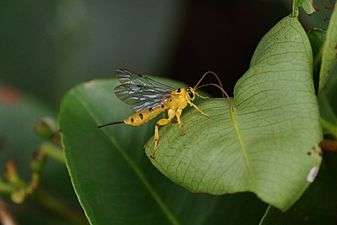 Female Xanthopimpla punctata. Ovipositor longer and more slender than stingers of aculeate wasps
Female Xanthopimpla punctata. Ovipositor longer and more slender than stingers of aculeate wasps_female.jpg) Echthrus reluctator, female
Echthrus reluctator, female
Oxfordshire
Ichneumonids are distinguished from their sister group Braconidae mainly on the basis of wing venation. The fore wing of 95% of ichneumonids has vein 2m-cu (in the Comstock–Needham system), which is absent in braconids. Vein 1rs-m of the fore wing is absent in all ichneumonids, but is present in 85% of braconids. In the hind wing of ichneumonids, vein rs-m joins Rs apical to (or rarely opposite) the split between veins Rs and R1. In braconids, vein rs-m joins basal to this split. The taxa also differ in the structure of the metasoma: about 90% of ichneumonids have a flexible suture between tergites 2 and 3, whereas these tergites are fused in braconids (though the suture is secondarily flexible in Aphidiinae).[6]
 Ichneumonid fore wing (Syzecteus sp.). The presence of vein 2m-cu and absence of vein 1Rs+M distinguish the wing from that of braconids. |  Ichneumonid hind wing. Vein rs-m joins Rs after the split between veins Rs and R1. | 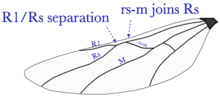 Braconid hind wing. Vein rs-m joins Rs before the split between veins Rs and R1. |
Distribution
Ichneumonids are found on all continents with the exception of Antarctica. They inhabit virtually all terrestrial habitats, wherever there are suitable invertebrate hosts.
The distribution of ichneumonid species richness is subject to ongoing debate. Long believed to be rare in the tropics, and at its most species rich in the temperate region, the family became a classic textbook example of an 'exceptional' latitudinal diversity gradient.[7] Recently this belief has been questioned, after the discovery of numerous new tropical species.[8][9][10]
Reproduction and diet
Some ichneumonid species lay their eggs in the ground, but most inject them either directly into their host's body or on its surface. After hatching, the ichneumonid larva consumes its still living host. The most common hosts are larvae or pupae of Lepidoptera, Coleoptera and Hymenoptera. For example, a species of ichneumonid has been found to lay eggs in African sugarcane borer larva, a moth common in sub-Saharan Africa.[11] Ichneumonids are also considered a primary enemy of the Arctic woolly bear moth.[12] Some species in the subfamily Pimplinae also parasitise spiders. Hyperparasitoids such as Mesochorinae oviposit inside the larvae of other ichneumonoids. The hosts of many species are unknown; host information has been summed up by e.g. Aubert,[13][14][15] Perkins.[16][17] and Townes.[18]
Ichneumonids use both idiobiont and koinobiont strategies. Idiobionts paralyze their host and prevent it from moving or growing. Koinobionts allow their host to continue to grow and develop. In both strategies, the host typically dies after some weeks, after which the ichneumonid larva emerges and pupates.
Adult ichneumonids feed on a diversity of foods, including plant sap, nectar and other insects. They spend much of their active time searching, either for hosts (female ichneumonids) or for emerging females (male ichneumonids).[19] The predation pressure exerted by ichneumonids can be tremendous, and they are often one of the major regulators of invertebrate populations.[20][21] It is quite common for 10-20% or more of a host's population to be parasitised (though reported parasitism rates often include non-ichneumonid parasitoids).[22][23]
 Zatypota albicoxa laying egg on a spider
Zatypota albicoxa laying egg on a spider Mating ichneumonids
Mating ichneumonids_parasitized_by_Acrodactyla_quadrisculpta_larva_(RMNH.INS.593867)_-_BDJ.1.e992.jpg) Larva of Acrodactyla quadrisculpta parasitising spider
Larva of Acrodactyla quadrisculpta parasitising spider_and_the_empty_skin_of_a_caterpillar_it_had_parasitized_(8073727904).jpg) Campoplegine pupa, with empty skin of caterpillar it parasitised above it
Campoplegine pupa, with empty skin of caterpillar it parasitised above it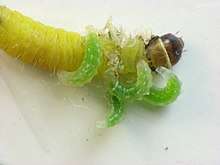 Hercus fontinalis larvae feeding on caterpillar
Hercus fontinalis larvae feeding on caterpillar
Taxonomy and systematics
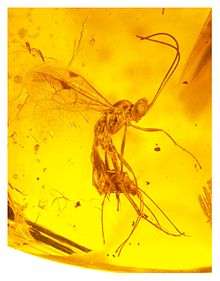
The taxonomy of the ichneumonids is still poorly known. The family is highly diverse, containing 24,000 described species. Approximately 60,000 species are estimated to exist worldwide, though some estimates place this number at over 100,000. They are severely undersampled, and studies of their diversity typically produce very high numbers of species which are represented by only a single individual.[24][25] Due to the high diversity, the existence of numerous small and hard to identify species, and the majority of species being undiscovered, it has proven difficult to resolve the phylogeny of the ichneumonids. Even the relationships between subfamilies are unclear. The sheer diversity also means DNA sequence data is only available for a tiny fraction of the species, and detailed cladistic studies require major computing capacity.
Extensive catalogues of the ichneumonids include those by Aubert,[13][14][15] Gauld,[26] Perkins,[16][17] and Townes.[18][27][28][29][30] Due to the taxonomic difficulties involved, however, their classifications and terminology are often confusingly contradictory. Several prominent authors have gone as far as to publish major reviews that defy the International Code of Zoological Nomenclature.[27][28][29][30][31][32]
The large number of species in Ichneumonidae may be due to the evolution of parasitoidism in hymenoptera, which occurred approximately 247 million years ago.[33][34] Ichneumonidae is the basal branch of Apocrita, the lineage in which parasitoidism in hymenoptera evolved, and some ichneumonids are thought to have been in stasis for millions of years and closely resemble the common ancestor in which parasitoidism evolved. This common ancestor was likely an Ectoparasitoid woodwasp that parasitized wood-boring beetle larvae in trees.[35] The family has existed since at least the Early Cretaceous (c. 125 mya),[36][37] but may have appeared some time before. It diversified during the Oligocene.
Subfamilies
In 1999, the ichneumonids were divided into 39 subfamilies,[38][39] whose names and definitions have varied considerably. Masoninae were added in 2019.[40] The phylogenetic relationships between the subfamilies are still unclear.
- Acaenitinae
- Adelognathinae
- Agriotypinae
- Anomaloninae (= Anomalinae)
- Banchinae
- Brachycyrtinae (sometimes included in Labeninae)
- Campopleginae (= Porizontinae)
- Collyriinae
- Cremastinae
- Cryptinae (= Gelinae, Hemitelinae, Phygadeuontinae)
- Ctenopelmatinae (= Scolobatinae)
- Cylloceriinae (sometimes included in Microleptinae)
- Diacritinae (sometimes included in Pimplinae)
- Diplazontinae
- Eucerotinae (sometimes included in Tryphoninae)
- Hybrizontinae (= Paxylommatinae) (sometimes placed in own family)
- Ichneumoninae
- Labeninae (= Labiinae)
- Labenopimplinae (extinct)
- Lycorininae (sometimes included in Banchinae)
- Masoninae
- Mesochorinae
- Metopiinae
- Microleptinae
- Neorhacodinae (sometimes included in Banchinae)
- Nesomesochorinae
- Ophioninae
- Orthocentrinae (sometimes included in Microleptinae)
- Orthopelmatinae
- Oxytorinae
- Pedunculinae
- Phrudinae
- Pimplinae (= Ephialtinae)
- Poemeniinae (sometimes included in Pimplinae)
- Rhyssinae (sometimes included in Pimplinae)
- Sisyrostolinae (sometimes included in Phrudinae)
- Stilbopinae (sometimes included in Banchinae)
- Tatogastrinae (sometimes included in Microleptinae)
- Tersilochinae
- Tryphoninae
- Xanthocryptus novozealandicus
- Xoridinae
Famous ichneumonologists
Famous ichneumonologists include:
Darwin and the Ichneumonidae
The apparent cruelty of the ichneumonids troubled philosophers, naturalists, and theologians in the 19th century, who found the parasitoid life style inconsistent with the notion of a world created by a loving and benevolent God.[41] Charles Darwin found the example of the Ichneumonidae so troubling that it contributed to his increasing doubts about the nature and existence of a Creator. In an 1860 letter to the American naturalist Asa Gray, Darwin wrote:
I own that I cannot see as plainly as others do, and as I should wish to do, evidence of design and beneficence on all sides of us. There seems to me too much misery in the world. I cannot persuade myself that a beneficent and omnipotent God would have designedly created the Ichneumonidae with the express intention of their feeding within the living bodies of Caterpillars, or that a cat should play with mice.[42]
Morphology
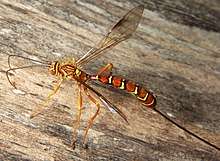 Megarhyssa greenei female
Megarhyssa greenei female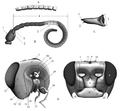 Morphology of the head and its processes: (А) head capsule; (В) antenna; (С) mandible[43]
Morphology of the head and its processes: (А) head capsule; (В) antenna; (С) mandible[43] Morphology of the thorax (D)[43]
Morphology of the thorax (D)[43] Morphology of the abdomen and processes of the thorax: (E) front wing; (F) leg III; (G) abdomen of female[43]
Morphology of the abdomen and processes of the thorax: (E) front wing; (F) leg III; (G) abdomen of female[43]
References
- Yu, D. S.; van Achterberg, C.; Horstmann, K. (2016). Taxapad 2016. Ichneumonoidea 2015 (Biological and taxonomical information), Taxapad Interactive Catalogue Database on flash-drive. Nepean, Ottawa, Canada.
- Quicke, D. L. J. (2015). The braconid and ichneumonid parasitoid wasps: biology, systematics, evolution and ecology. Chichester: John Wiley & Sons, Ltd.
- Broad, G. R.; Shaw, M. R.; Fitton, M. G. (2018). Ichneumonid wasps (Hymenoptera: Ichneumonidae): their classification and biology. Handbooks for the Identification of British Insects, 7(12): 1-418.
- Klopfstein, Seraina; Santos, Bernardo F.; Shaw, Mark R.; Alvarado, Mabel; Bennett, Andrew M. R.; Dal Pos, Davide; Giannotta, Madalene; Herrera Florez, Andres F.; Karlsson, Dave; Khalaim, Andrey I.; Lima, Alessandro R. (2019). "Darwin wasps: a new name heralds renewed efforts to unravel the evolutionary history of Ichneumonidae". Entomological Communications. 1: ec01006.
- Aristotle (2015) [343 BC]. The Complete Aristotle. Booklassic. p. section 87, chapter 20. ISBN 978-963-525-370-8.
The wasps that are nicknamed 'the ichneumons' (or hunters), less in size, by the way, than the ordinary wasp, kill spiders and carry off the dead bodies to a wall or some such place with a hole in it; this hole they smear over with mud and lay their grubs inside it, and from the grubs come the hunter-wasps. ... The eagle and the snake are enemies, for the eagle lives on snakes; so are the ichneumon and the venom-spider, for the ichneumon preys upon the latter.
- Sharkey, M.J. (1993), Family Braconidae, pp. 362-394. In: Goulet, H. and J. Huber (eds.). Hymenoptera of the World, an Identification Guide to Families, Agriculture Canada Research Branch Monograph No. 1894E.
- Janzen, Daniel H. (1981-06-01). "The Peak in North American Ichneumonid Species Richness Lies Between 38 Degrees and 42 Degrees N". Ecology. 62 (3): 532–537. doi:10.2307/1937717. ISSN 1939-9170. JSTOR 1937717.
- Sime, K. R.; Brower, A. V. Z. (1998). "Explaining the latitudinal gradient anomaly in ichneumonid species richness: Evidence from butterflies". Journal of Animal Ecology. 67 (3): 387. doi:10.1046/j.1365-2656.1998.00198.x. JSTOR 2647379.
- Veijalainen, A.; Wahlberg, N.; Broad, G. R.; Erwin, T. L.; Longino, J. T.; Saaksjarvi, I. E. (2012). "Unprecedented ichneumonid parasitoid wasp diversity in tropical forests". Proceedings of the Royal Society B: Biological Sciences. 279 (1748): 4694–4698. doi:10.1098/rspb.2012.1664. PMC 3497088. PMID 23034706.
- Quicke, D. L. J. (2012). "We Know Too Little about Parasitoid Wasp Distributions to Draw Any Conclusions about Latitudinal Trends in Species Richness, Body Size and Biology". PLoS ONE. 7 (2): e32101. Bibcode:2012PLoSO...732101Q. doi:10.1371/journal.pone.0032101. PMC 3280234. PMID 22355411.
- Conlong, D. E.; Graham, D. Y.; Hastings, H. (March 1988). "Notes on the natural host surveys and laboratory rearing of Goniozus natalensis Gordh (Hymenoptera: Bethylidae), a parasitoid of Eldana saccharina Walker (Lepidoptera: Pyralidae) larvae from Cyperus papyrus L. in Southern Africa". Journal of the Entomological Society of Southern Africa. 51 (1): 115–127. hdl:10520/AJA00128789_2538. ISSN 0013-8789.
- Várkonyi, Gergely; Roslin, Tomas (2013). "Freezing cold yet diverse: Dissecting a high-Arctic parasitoid community associated with Lepidoptera hosts". The Canadian Entomologist. 145 (2): 193–218. doi:10.4039/tce.2013.9.
- Aubert, Jacques (1969). Les Ichneumonides ouest-palearctiques et leurs hotes 1. Pimplinae, Xoridinae, Acaenitinae [The Western Palearctic ichneumon wasps and their hosts. 1. Pimplinae, Xoridinae, Acaenitinae] (in French). Paris: Laboratoire d'Evolution des Etres Organises. OCLC 773541612.
- Aubert, Jacques François (1978). Les Ichneumonides ouest-palearctiques et leurs hotes 2. Banchinae et Suppl. aux Pimplinae [The Western Palearctic ichneumon wasps and their hosts. 2. Banchinae and supplement to the Pimplinae] (in French). Paris & EDIFAT-OPIDA, Echauffour: Laboratoire d'Evolution des Etres Organises. OCLC 461814920.
- Aubert, Jacques (2000). Les Ichneumonides ouest-paléarctiques et leurs hôtes. 3. Scolobatinae (=Ctenopelmatinae) et suppl. aux volumes précédents [The West Palaearctic ichneumonids and their hosts. 3. Scolobatinae (= Ctenopelmatinae) and supplements to preceding volumes]. Litterae Zoologicae (in French). 5. OCLC 716442080.
- Perkins, J. F. (1959). Ichneumonidae, key to subfamilies and Ichneumoninae – 1. Handbook for the Identification of British Insects. 7 (part 2ai). OCLC 704042974.
- Perkins, J. F. (1960). Hymenoptera: Ichneumonoidea: Ichneumonidae, subfamilies Ichneumoninae 2, Alomyinae, Agriotypinae and Lycorininae. Handbook for the Identification of British Insects. 7 (part 2aii). OCLC 316445110.
- Townes, Henry; Momoi, Setsuya; Townes, Marjorie (1965). A catalogue and reclassification of the eastern Palearctic Ichneumonidae. Memoirs of the American Entomological Institute. 5. OCLC 669390657.
- Olson, D. M.; Takasu, K.; Lewis, W. J. (2005). "Food needs of adult parasitoids: Behavioral adaptations and consequences". Plant-Provided Food for Carnivorous Insects. pp. 137–147. doi:10.1017/CBO9780511542220.006. ISBN 9780521819411.
- Várkonyi, Gergely; Hanski, Ilkka; Rost, Martin; Itämies, Juhani (September 2002). "Host-Parasitoid Dynamics in Periodic Boreal Moths". Oikos. 98 (3): 421–30. doi:10.1034/j.1600-0706.2002.980306.x. JSTOR 3547182.
- Hawkins, Bradford A.; Cornell, Howard V.; Hochberg, Michael E. (October 1997). "Predators, Parasitoids, and Pathogens as Mortality Agents in Phytophagous Insect Populations". Ecology. 78 (7): 2145–52. doi:10.1890/0012-9658(1997)078[2145:PPAPAM]2.0.CO;2. JSTOR 2265951.
- Memmott, J.; Godfray, H.C.J.; Gauld, I.D. (July 1994). "The Structure of a Tropical Host-Parasitoid Community". Journal of Animal Ecology. 63 (3): 521–40. doi:10.2307/5219. JSTOR 5219. INIST:4125431.
- Várkonyi, Gergely; Roslin, Tomas (2013). "Freezing cold yet diverse: dissecting a high-Arctic parasitoid community associated with Lepidoptera hosts". The Canadian Entomologist. 145 (2): 193–218. doi:10.4039/tce.2013.9.
- Saunders, Thomas E.; Ward, Darren F. (2018-04-05). "Variation in the diversity and richness of parasitoid wasps based on sampling effort". PeerJ. 6: e4642. doi:10.7717/peerj.4642. ISSN 2167-8359. PMC 5889912. PMID 29632746.
- Fraser, Sally E. M.; Dytham, Calvin; Mayhew, Peter J. (2008-02-01). "The effectiveness and optimal use of Malaise traps for monitoring parasitoid wasps". Insect Conservation and Diversity. 1 (1): 22–31. doi:10.1111/j.1752-4598.2007.00003.x. ISSN 1752-4598.
- Gauld, I. D. (1976). "The classification of the Anomaloninae (Hymenoptera: Ichneumonidae)". Bulletin of the British Museum (Natural History) Entomology. 33: 1–135.
- Townes, H. K. (1969a). "Genera of Ichneumonidae, Part 1 (Ephialtinae, Tryphoninae, Labiinae, Adelognathinae, Xoridinae, Agriotypinae)". Memoirs of the American Entomological Institute. 11: 1–300.
- Townes, H. K. (1969b). "Genera of Ichneumonidae, Part 2 (Gelinae)". Memoirs of the American Entomological Institute. 12: 1–537.
- Townes, H. K. (1969c). "Genera of Ichneumonidae, Part 3 (Lycorininae, Banchinae, Scolobatinae, Porizontinae)". Memoirs of the American Entomological Institute. 13: 1–307.
- Townes, H. K. (1971). "Genera of Ichneumonidae, Part 4 (Cremastinae, Phrudinae, Tersilochinae, Ophioninae, Mesochorinae, Metopiinae, Anomalinae, Acaenitinae, Microleptinae, Orthopelmatinae, Collyriinae, Orthocentrinae, Diplazontinae)". Memoirs of the American Entomological Institute. 17: 1–372.
- Oehlke, J (1966). "Die westpaläarktische Arte der Tribus Poemeniini (Hymenoptera, Ichneumonidae) ["The Western Palearctic species of the tribe Poemeniini"]". Beiträge zur Entomologie. 15: 881–892.
- Oehlke, J (1967). "Westpaläarktische Ichneumonidae 1, Ephialtinae". Hymenopterorum Catalogus (new ed.). 2: 1–49.
- Peters, Ralph S.; Krogmann, Lars; Mayer, Christoph; Donath, Alexander; Gunkel, Simon; Meusemann, Karen; Kozlov, Alexey; Podsiadlowski, Lars; Petersen, Malte (2017-04-03). "Evolutionary History of the Hymenoptera". Current Biology. 27 (7): 1013–1018. doi:10.1016/j.cub.2017.01.027. PMID 28343967.
- Heraty, John; Ronquist, Fredrik; Carpenter, James M.; Hawks, David; Schulmeister, Susanne; Dowling, Ashley P.; Murray, Debra; Munro, James; Wheeler, Ward C. (2011). "Evolution of the hymenopteran megaradiation". Molecular Phylogenetics and Evolution. 60 (1): 73–88. doi:10.1016/j.ympev.2011.04.003. PMID 21540117.
- Pennacchio, Francesco; Strand, Michael R. (2005-12-06). "Evolution of developmental strategies in parasitic hymenoptera". Annual Review of Entomology. 51 (1): 233–258. doi:10.1146/annurev.ento.51.110104.151029. ISSN 0066-4170. PMID 16332211.
- Kopylov, D. S. (January 2009). "A new subfamily of ichneumonids from the Lower Cretaceous of Transbaikalia and Mongolia (Insecta: Hymenoptera: Ichneumonidae)". Paleontological Journal. 43 (1): 83–93. doi:10.1134/S0031030109010092. ISSN 0031-0301.
- Kopylov, D. S. (March 2010). "Ichneumonids of the subfamily Tanychorinae (Insecta: Hymenoptera: Ichneumonidae) from the Lower Cretaceous of Transbaikalia and Mongolia". Paleontological Journal. 44 (2): 180–187. doi:10.1134/S0031030110020097. ISSN 0031-0301.
- Wahl, David (1999): Classification and Systematics of the Ichneumonidae (Hymenoptera) Archived 2008-07-25 at the Wayback Machine. Version of 1999-JUL-19. Retrieved 2008-JUN-18.
- Wahl, David; Gauld, Ian. "American Entomological Institute". Genera Ichneumonorum Nearcticae. The American Entomological Institute. Retrieved 9 August 2017.
- Quicke, Donald L. J.; Austin, Andrew D.; Fagan‐Jeffries, Erinn P.; Hebert, Paul D. N.; Butcher, Buntika A. (2020). "Molecular phylogeny places the enigmatic subfamily Masoninae within the Ichneumonidae, not the Braconidae". Zoologica Scripta. 49: 64–71. doi:10.1111/zsc.12390.
- "Nonmoral Nature". Archived from the original on 2015-11-17. Retrieved 2011-04-05.
- "Letter 2814 — Darwin, C. R. to Gray, Asa, 22 May [1860]". Retrieved 2011-04-05.
- Tereshkin, A. (2009): Illustrated key to the tribes of subfamilia Ichneumoninae and genera of the tribe Platylabini of world fauna (Hymenoptera, Ichneumonidae). Linzer biol. Beitr. 41/2: 1317-1608. PDF
External links
| Wikimedia Commons has media related to Ichneumonidae. |
| Wikispecies has information related to Ichneumonidae |
- Long Family Description Many illustrations from John Curtis British Entomology
- Fauna Europaea
- Ichneumonidae:Classification of afrotropical ichneumonid wasps. Extensive use of images.
- Family Ichneumonidae at EOL Comprehensive taxonomic resource and image database
- Images of Ichneumonidae species in New Zealand
- W.Rutkies Images. Authority id.
- Genera Ichneumonorum Nearctica. Morphology of Ichneumonidae